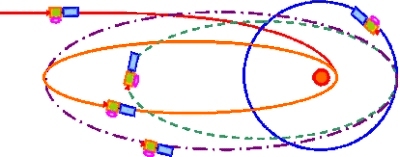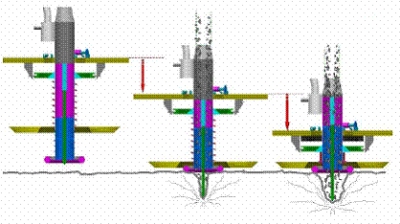Deimos Sample Return
Mission Architecture
 |
|
Deimos Sample Return: Mars orbit insertion and Deimos co-orbit. The spacecraft is inserted into a highly elliptical orbit of Mars (solid line). The pericenter is raised so that the spacecraft reaches the Deimos orbit (dot-dashed line), followed by several apocenter reduction manoeuvres (dashed line) to circularise the orbit to a Deimos co-orbit (solid blue line). |
The DSR architecture consists of a small or mini spacecraft, launched into the Mars-Deimos System on a Soyuz Fregate 2B. The spacecraft is launched into an elliptical orbit (200 × 25 000 km), after which it will begin its transfer to the Martian system. Upon reaching Mars, the spacecraft will be placed into a highly elliptical orbit (500 × 100 000 km), before performing a series of manoeuvres to enter into a co-orbiting trajectory with Deimos (20 069 km circular orbit). The spacecraft will then enter into an observation mode, performing measurements of Deimos' surface and gravitational properties before obtaining the samples.
Once the samples are obtained they will be transferred into a canister inside the Earth Entry Vehicle (EEV). Upon approaching Earth the EEV will separate and perform a direct re-entry.
The Challenges
The DSR Technology Reference Study is intended to identify the technologies required for a sample return mission to a small solar system body. The following issues have been identified as enabling technologies for such a mission:
Sample Collection/Handling Mechanism(s): The design and development of a sampling mechanism capable of collecting a 1 kg sample of regolith from a small body is critical for the feasibility of a DSR mission. The mechanism needs to be optimized for use on such a small, low gravity body in order to reduce mission requirements.
 |
|
Schematic of the sample mechanism |
Highly Autonomous Guidance Navigation and Control System: Collecting a sample from the surface of a small body, with only a small gravitational field, presents several challenges. The approach towards, and any contact with, the surface must be strictly controlled. Real time control during these critical manoeuvres will not be possible. A highly autonomous guidance, navigation and control system is therefore necessary.
Direct Earth Re-Entry Vehicle: As for any sample return mission an Earth re-entry vehicle is required to return the sample safely to the ground. This recoverable vehicle must also comply with any planetary protection requirements.
Study details
This TRS study was completed in 2006. It was performed by SRE-PAP with the assistance of Alcatel Alenia Space (spacecraft and mission design), EADS Astrium (mission analysis) and Cosine Research B.V. (payload design).
Contact Information
For further information about this study please contact the study manager:
Dr. Peter Falkner
Head of Planetary and Solar System Exploration Studies Section (SRE-PAP)
Advanced Studies and Technology Preparation Division (SRE-PA)
European Space Agency, ESA-ESTEC
Postbus 299, NL-2200 AG Noordwijk, The Netherlands
tel: +31 71 565 5363
e-mail: Peter.Falkner esa.int
esa.int
